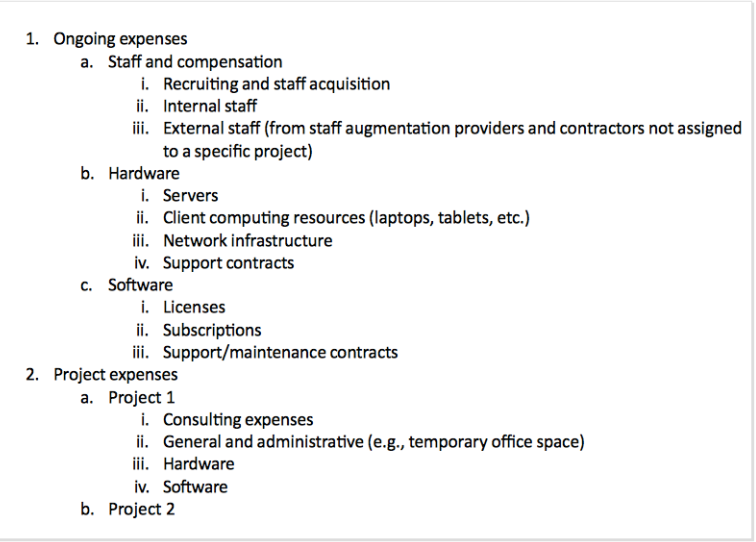 Creating an IT budget isn’t always easy for CFOs of small to midsize businesses. You’re busy keeping the business wheels turning to ensure the cash flow is there to sustain growth, analyzing key metrics, collecting accounts receivable, and reviewing reports.
Creating an IT budget isn’t always easy for CFOs of small to midsize businesses. You’re busy keeping the business wheels turning to ensure the cash flow is there to sustain growth, analyzing key metrics, collecting accounts receivable, and reviewing reports.
Depending on the size of your organization and your business goals, your IT budget can be an important tool to analyze your IT spending accurately so there are no surprises or unexpected costs. With many businesses struggling due to inflation, let alone a pending recession, it’s important to consider all the spending categories and where your dollars will have the most impact. Be certain to tap an IT services partner who knows your business and your IT needs. They will be an asset to either creating an IT budget for you or helping you build your annual budget.
So, where is a good place to start? Read on so that you can hit the ground running, then check out our IT budget checklist blog.
Four tips to help you get started on your SMB IT budget:
1. Create a benchmark comparison by asking: What is my industry’s average IT budget?
Conduct some research and find reliable sources that reflect how much of the total budget is spent on IT for your industry. This information alone will not determine how much your company will pay, however, it gives you a place to start and a comparison point. Consider the following:
- Are you growing or maintaining your business?
- How much growth are you striving for?
- What additional business goals have you set?
- How does an investment in technology help you meet your goals?
- What technology does it take to maintain your business, or make it more effective and efficient?
The information below reflects the average IT budget for a handful of broad industry categories as a percentage of revenue for 2020 and 2022, with a forecast of IT spending in 2023.
Average IT Budget as a Percentage of Revenue
| Industry | 2020 | 2022 | 2023 |
|
Technology & Cloud Communication |
6.47% | 11% | 16% |
| Business Services |
4.64% |
10% | 15% |
| Travel & Media |
4.44% |
5% | 10% |
| Healthcare Services |
4.36% |
5% | 10% |
| Consumer business | 2% | 3% | 8% |
| Industrial & Manufacturing | 1.68% | 2% | 7% |
Deloitte Insights reported that minimal revenue was attributed to IT budgets in 2020, whereas Statista showed IT budgets over time have doubled for most industries. Gartner forecasts SMB IT spending will grow by more than 5 percent, mainly due to the adoption of cloud technologies as businesses allow staff members to work remotely or hybrid.
The increase in cyberattacks is another reason companies are increasing their IT budget. IT security tools, resources, and staff training are necessary to add to your budget and provide what you need to have in place to obtain cybersecurity insurance and protect your business.
2. Gather information on anticipated spending
Creating an IT budget requires establishing your short- and long-term goals and collecting an inventory of your business’s resources and expenses. What are the priorities? Are there any tools not in use anymore? What equipment has reached the end of its lifecycle?
Once complete, assemble a list of specific expenses for your small business IT budget. Tech Republic outlines items like this:

[Snapshot from TechRepublic]
Remember, this is a general list of items you need to gather information on. You might have to include more specific items or even a miscellaneous category for business activities or items that don’t fit into one of these sections.
This exercise provides an organized picture of what you have, what you need, and what you’re looking for when making future technology upgrades and purchases in the coming year.
3. Formatting the IT Budget
When putting together your IT budget, you will need to create a spreadsheet with multiple tables or tabs for specific categories. With each table, you will need to record last year’s spending, the current year's projected IT spending, and the difference for comparison. Then break down the specific categories to determine how much you will invest.
For this example, we’ll use Tech Republic’s general list, such as their Ongoing Expenses- Software budget, as an IT budget template.
Let’s assume that the company building the budget category below is a law firm with $10 million in annual revenue. They decided they wanted to invest in their software expenses this incoming year, increasing their licensing, subscription, and contracting spending.
IT Budget: Ongoing Software Expenses
| Expenses Item | Last Year's Spend | Projected IT Spend | Difference |
| Licenses | $2,450 | $2525 | +$75 |
| Subscriptions | $12,384 | $13,896 | +$1,512 |
| Support & Maintenance Contracts | $2,600 | $2,675 | +$75 |
| Total | $17,434 | $19,096 | +$1,662 |
Of course, this is only an example, a template for you to draw from as you begin specifically allocating money to different areas of your IT.
4. Use your IT budget throughout the year
An IT budget isn’t something you create at the beginning of the year and never touch again. Your budget is meant to influence purchasing decisions and help you prioritize what purchases do not need to be made.
Here are some best practices you can implement to utilize your IT budget to the fullest:
- Use your accounting software system to the fullest. Enter your IT budget and compare it to the expenses incurred.
- Meet with the department heads every quarter to ensure company IT spending is on track with what was established at the beginning of the year. It will also provide an opportunity to discuss any changes to spending priorities.
- Include an IT consultant to provide expert recommendations for your technology goals.
- A couple of months before the year ends, start looking over the IT budget and begin preparations for next year’s spending.
Establish an IT Budget with Expert Recommendations
While creating a general IT budget doesn’t take much time, creating an accurate IT budget that anticipates future spending will make business decisions quicker and help you with cash flow. Partner with an expert that will provide valuable insight, specifically for what you need, and eliminate unnecessary spending, saving you time and money.
Contact us if your small to midsize business needs help creating an IT budget. At CoreTech, we curate IT budgets and tech roadmaps annually, so our clients start their year off knowing the direction their business wants to go in terms of technology. Book an appointment today and tell us what you want to accomplish.

